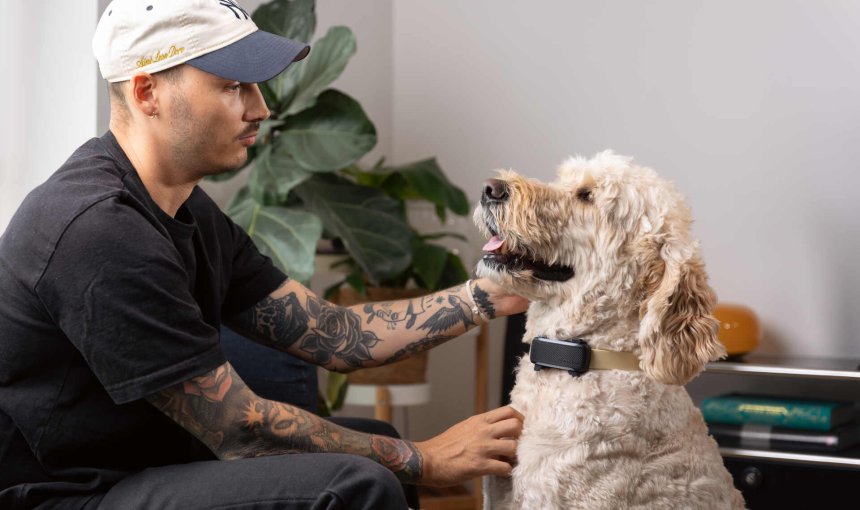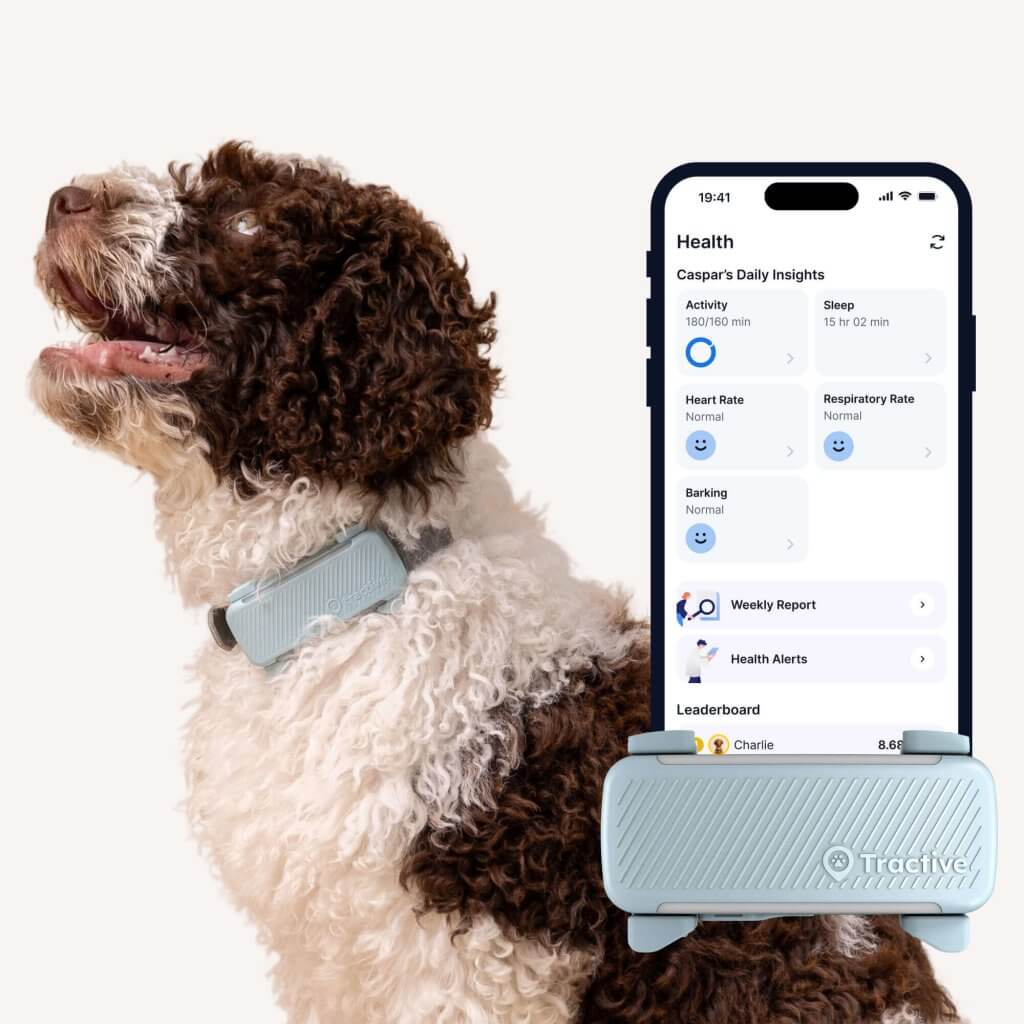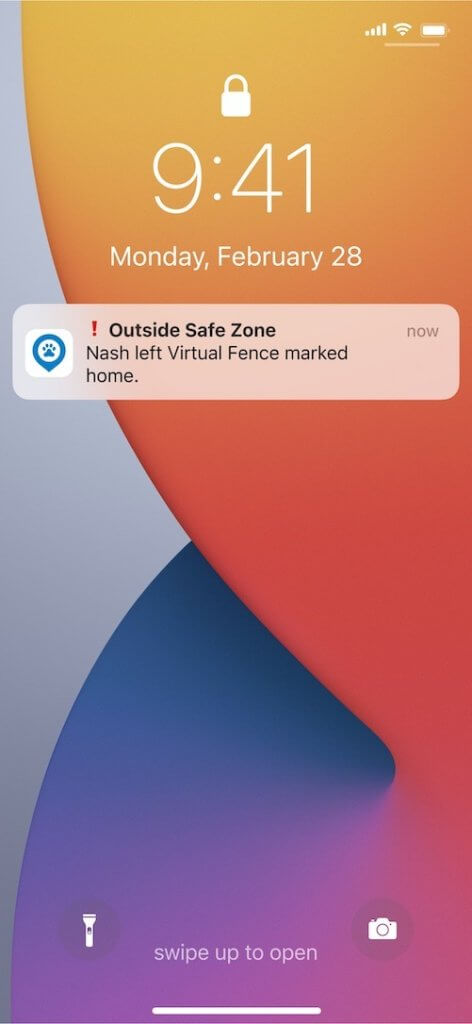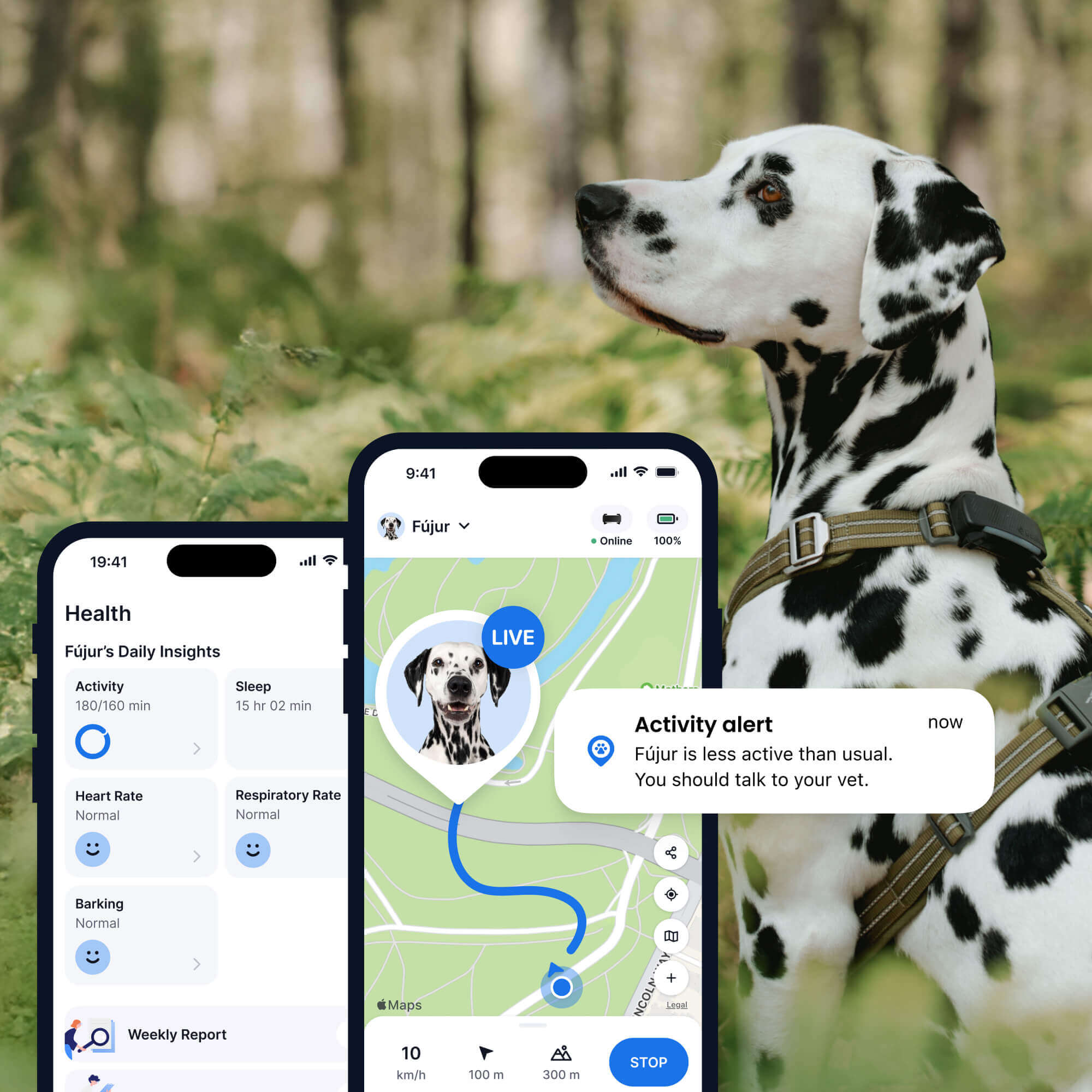How To Calm A Dog With Dementia At Night
Caring for a dog with dementia can be a challenge - but it needn't be. Here are some tips on how to deal with the "sundowning" effect.

Watching your dog struggle with the confusion and anxiety of dementia can be heartbreaking – especially around bedtime. So if you’re wondering how to calm a dog with dementia at night, you’re not alone in this. Many dog parents face the “sundowning” phenomenon, where their dogs become restless, disoriented, and anxious. In this guide, we’ll cover some steps you can take to make the nights easier for both of you. (And where a smart dog tracker with Sleep Tracking can help.)
Key Takeaways
The “sundowning” effect is a common symptom of Canine Cognitive Dysfunction (CCD). It’s characterized by confusion, anxiety, and restlessness in senior dogs at night.
You can help calm your dog by creating a predictable nighttime routine, a safe and cozy space, and using calming aids like pheromone diffusers or gentle music.
Safety first: use baby gates to block off stairs and other unsafe areas, and be mindful of your dog’s declining senses to prevent accidents.
A smart dog tracker like Tractive can help you catch on to any sleep disturbances your dog is experiencing (one of the first signs of CCD.) Else, if your dog can access the outdoors, it can help you find them right away if they wander off.
Understanding Canine Cognitive Dysfunction (CCD)
Canine Cognitive Dysfunction (CCD), often referred to as “dog dementia,” is a neurodegenerative disorder. It’s very similar to Alzheimer’s disease in humans. It’s a natural part of aging for many dogs, and it causes changes in their brain function. Some common symptoms of CCD include:
- Disorientation
Your dog might stare blankly at walls, get “stuck” in corners, or seem lost in a familiar environment. - Changes in social interaction
They might become more withdrawn or, conversely, more clingy. They may not greet you or other family members with the same enthusiasm. - Changes to the sleep-wake cycle
A dog with CCD might sleep more during the day and be awake, pacing, and anxious at night. - Doing their business indoors
They may forget their house training and have accidents indoors. - Changes in activity level
They might be less interested in playing or go on long, aimless walks.
💡A smart dog tracker with Sleep Tracking can help you catch on to these changes quicker – like a shift in your dog’s sleeping behavior. So you can take action earlier and get them checked up at the vet much in advance.

Get health alerts for your dog
Our pups can’t always tell us if something’s wrong. But if their tracker detects unusual changes in their routine, you’ll get an alert, helping you catch potential issues early.
Why nighttime is especially hard for dogs with dementia
As daylight fades, the lack of visual cues can be frightening and disorienting for your dog. (Worse so if their vision is already declining.) During the day, there’s a constant stream of familiar sights, sounds, and smells that provide comfort and routine. At night, with the house quiet and still, this sensory input is gone, leaving them to feel isolated and confused.
As they grow older, senior dogs might also experience a loss of their other senses. A dog whose hearing is failing won’t hear the familiar sound of a family member moving around upstairs. A loss of smell can remove another key way they orient themselves in their environment. The world they know becomes much smaller, quieter, and more confusing after dark.
This is why the “sundowning” effect is a well-documented phenomenon in both humans and dogs with dementia. The exact cause isn’t fully understood, but it’s believed to be related to the disruption of the internal body clock.
How to calm a dog with dementia at night
Follow a predictable routine
Dogs with CCD thrive on routine. Stick to a consistent schedule for meals, potty breaks, and bedtime. This predictability can reduce anxiety by helping them know what to expect. A final potty break right before bed is crucial. A simple routine could look like a small, low-impact walk or a last-minute outdoor break at the same time each night, followed by a treat and a trip to their bed. Consistency is key to creating a sense of security and safety.
Read More: How To Get Your Dog To Sleep Through The Night
Create a safe and cozy space
Keep a specific, quiet spot in your home as your dog’s nighttime “den.” This could be a crate or a bed in a small, low-traffic room. Fill it with a warm, comfortable blanket and a familiar item that smells like you. This space should be a sanctuary where they feel safe and secure. Make sure it’s free of clutter and objects they could bump into. Placing their bed near yours can also provide extra reassurance.
Consider using calming aids
Like, for example:
- Pheromone diffusers
These mimic the scent a mother dog releases to calm her puppies. Using a diffuser in their sleep area can create a sense of peace. - Calming music or white noise
Gentle, calming music or a white noise machine can help muffle disruptive nighttime sounds and provide a soothing auditory background. You can find playlists specifically for dogs on streaming services. - Supplements
Talk to your vet about calming supplements that might be helpful. These include ingredients that can sometimes help regulate sleep cycles. Avoid giving your dog any medication meant for humans, as these might be toxic to them. - ThunderShirts
Which provide comforting pressure on your dog, similar to swaddling a baby. (Or using a weighted blanket.) Just make sure to get the green light from your vet first.
Keep your dog well-exercised
A tired dog is a calm dog. Make sure your dog gets enough exercise and mental activity during the day. This doesn’t mean a marathon walk -short, sniff-focused walks, puzzle toys, and gentle training sessions can be incredibly effective. Even 15 minutes of scent work, where you hide treats around a room, can be mentally tiring and help them feel more relaxed by bedtime.
Read More: How to Keep Your Dog Mentally Active: 7 Fun Activities
Keep a nightlight on
A soft, dim light can prevent your dog from being startled by shadows or getting lost in the dark. It also helps them navigate to their water bowl or their potty spot. You can also leave a small lamp on in their room to reduce the sudden shock of a dark room. A nightlight will also help if your dog is in the habit of wandering around the house after dark.
Stay close by
If your dog wakes up and seems anxious, a gentle touch can be very reassuring. Simply placing a hand on them, stroking their fur, or speaking to them in a calm, soft voice can help ground them in the moment and remind them they are safe. A little bit of extra love and attention can go a long way.
Rule out other, underlying health issues
Sometimes, what looks like dementia-related anxiety is actually caused by pain or discomfort. Arthritis, bladder issues, or other health problems can make it hard for a dog to get comfortable at night. A check-up with your vet is a must to rule out any underlying medical causes. They can check for conditions that might be causing them discomfort and recommend a suitable course of action.
More ways to keep your dog safe at night
Besides the calming techniques above, it’s important to consider your dog’s physical safety during the night. (Especially as they may become more disoriented.) That’s why we recommend you also:
- Block off unsafe areas
Use baby gates to block off stairs, open doorways to rooms with hazards, or any area where your dog might get stuck or suffer a fall. This prevents them from wandering into dangerous spaces while you’re asleep. - Watch out for hearing loss
As with vision, a dog’s hearing can decline with age. If your dog is startled or seems anxious when you enter a room, they may not have heard you coming. Speak in a gentle, slightly louder voice, or make a little noise (like tapping on the floor) to alert them to your presence before you touch them. - Use doggy diapers for accidents
If nighttime soiling becomes a frequent problem, a doggy diaper can be a simple solution. This can help keep your home clean and prevent your dog from feeling ashamed or distressed about an accident. Be sure to change them regularly to prevent skin irritation. - Keep their bed accessible
Ensure their bed or den is easy to get to. For dogs with mobility issues, a ramp can be a great way to help them get on and off the bed without pain. Else, an orthopedic bed can help dogs with joint pain. - Make sure your dog is easy to identify
Especially if they can access the outdoors during nighttime. This means a collar and ID tag at the very least, and a microchip for extra safety. If your dog wanders off from home or your yard, they might be too disoriented to sniff their way back home.
Where a smart dog tracker can monitor your dog’s health & well-being
Monitoring your dog during nighttime isn’t the easiest. That’s where technology can lend a hand. A smart dog tracker like Tractive can provide peace of mind and valuable data to help you care for your dog with dementia.
Strapped to your dog’s collar, you can now:
- Keep an eye on your dog’s sleeptime behavior
With its built-in motion detector, your Tractive tracker includes Sleep Tracking, which can be incredibly useful for a dog with CCD. Since a disrupted sleep-wake cycle is a key symptom, this data can help you track the quality and duration of your dog’s sleep, identify patterns of restlessness or disturbed sleep, and notice any changes over time. (Which can indicate the progression of their condition.) - Spot potential health issues early
Missed a day of tracking? Your tracker sends you a Health Alert if there’s a weird change in your dog’s activity levels or sleep quality. So you can take action earlier and get them checked up at the vet that much quicker.
- Find your dog if they wander off during nighttime
A common behavior for dogs with dementia is wandering aimlessly. Your trusty Tractive device also includes real-time GPS location, so you can always know where they are. With just a glance at your phone, LIVE tracking updates your dog’s location every couple of seconds. And unlike an AirTag, your Tractive device doesn’t need a network of compatible devices to work. Nor is it limited to any range. - Prevent your dog from escaping home
From your Tractive mobile app, you can also set up a Virtual Fence around your home or yard. You’ll get an instant escape alert if your dog wanders out of this safe zone. (Or enters a “no go zone” instead.)


Now the next time you’re at your vet, instead of just saying, “He seems to be struggling at night,” you can provide objective data on their sleep patterns and activity levels. Allowing for a more productive conversation and a more targeted treatment plan.
Caring for a dog with dementia is a journey that requires patience, love, and a bit of creativity. By understanding their condition and using the right strategies and tools, you can help them feel safe and loved, even when it’s dark outdoors.
And if you’ve liked this post, share it with a friend or a loved one – and let’s help build a safer, kinder world for our furry friends together.




